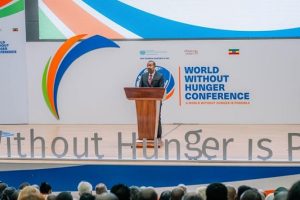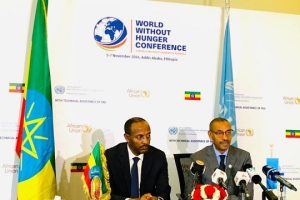
In the Russian Federation, the year 2023 is marked as a year of Africa. In July, there will be a second Russia-Africa Summit, taking place in St. Petersburg. In addition to that, another significant date should be noted. In February, it is already 125 years since the establishment of official diplomatic relations between Russia and Ethiopia.
Most people in our society do not know much about Ethiopia, and the only association that the average person has, when the name of the country is mentioned, is Hannibal, great-grandfather of A.S. Pushkin. However, Ethiopia has a rich history, culture and its unifying role in Africa – the headquarters of the African Union is located in Addis Ababa. The Russian poet Nikolay Gumilyov travelled through this distant country and assembled a large collection of African culture items, which is now displayed in the Kunstkamera Museum of St. Petersburg.
Despite strong cultural differences, the Orthodox religion contributed to the spiritual rapprochement of our countries. Without going too deep into theological distinctions, Ethiopia is also a largely Orthodox country, only with a theological tradition of the 5-th century, the so-called pre-Chalcedonian. Therefore, Orthodox Christianity is one of the major motives for rapprochement.
Russia’s and Ethiopia’s interest in each other arose long before the establishment of diplomatic relations. In the last years of his reign, Peter the Great wanted to send an embassy or expedition to Ethiopia. However, his intention was not destined to be fulfilled.
In 1898, several reasons finally allowed the two powers to formally establish diplomatic relations: after the victory over Turkey in 1878 in the Middle East and Northeast Africa, Russia’s influence there grew more and more. Besides, Russia had a forced necessity to resist British influence in Africa.
From the Russian Orthodox Church side, Archimandrite Porfiry Uspensky – the head of the Russian Orthodox spiritual mission in the Holy Land, conveyed deep interest to Ethiopia. In 1866, in the article “Russia’s Participation in the Fate of Abyssinia”, he submitted a plan for rapprochement between the two countries to government authorities.
There were also notable activities of doctors from the Russian Red Cross Society, who helped the wounded after the Italo-Ethiopian war. Russian travellers, who visited Ethiopia, also suggested the Russian government to get closer to this country. On the Ethiopian side, too, repeated attempts were made to establish relations between the two countries.
Another reason for the establishment of official diplomatic relations was given in the article by S.D. Molchanov, Colonel of the General Staff, published in 1896 in the newspaper “Sankt-Peterburgskiye Vedomosti” under the heading “The Significance of Abyssinia”. He wrote:
“At first glance, it may seem that Russia has no interests in Africa: we don’t need colonies, since Siberia will last for many years, it’s easy to start trade relations when we have Asia at our side, and even with the inertia of our merchants, it is simply an idle business…
Nevertheless, it looks different, when viewed from a broader point of view, not just land acquisitions and commercial gains. An alliance with Ethiopia, like the French-Russian alliance, is a political necessity, and therefore, Russia is called upon, to the best of its ability and capacity, to support the Ethiopian empire.
On February 17, 1898, the official history of diplomatic relations between Russia and Ethiopia began. Diplomat P.M. Vlasov successfully coped with his difficult task to justify the honour given to him by Nicholas II to be a political adviser but, at the same time, not to quarrel with the representative offices of European powers. For his good service, Negus-negest (Emperor) of Ethiopia Menelik II, awarded Vlasov with the Order of the Ethiopian Star.
Unfortunately, diplomatic relations were interrupted for a long period due to a 1917 revolutions in Russia and were resumed only in 1943 at the initiative of Ethiopia. Nevertheless, Ethiopia is one of the few countries in the world and the only one in Africa, with which Russia has such a long history of bilateral relations without imposing conditions on each other and seeking its own benefit.
During the speech of Emperor Haile Selassie I, at a meeting of the League of Nations in 1936, when fascist Italy had already occupied Ethiopia, the USSR was one of the few countries that came out in support of Ethiopia. The League of Nations did not protect the African country. Ethiopia remained a monarchy until 1975, during which time Emperor Haile Selassie I visited the Soviet Union several times, each time with a different result because there were always various incidents taking place.
On one of his visits, the Emperor awarded the Chairman of the Presidium of the Supreme Soviet of the USSR with the highest order of Ethiopia. It was necessary to answer symmetrically, but it would be paradoxical to present the Order of Labour or the Red Banner to the monarch. Then Haile Selassie was awarded the First degree Order of Suvorov as a participant in the fight against fascism.
The professor of history in RUDN (Russian University of People’s Friendship), Nigusie Kassae Mikael, published a monography about Haile Selassie. Being of the Ethiopian origin, Dr. Nigusie put a lot of efforts to make a contribution for the friendship of our two nations. Ideological incidents include the case when the atheistic Soviet authorities invited the Patriarch of the Orthodox Church to establish interaction with the deeply religious Ethiopian people.
For our church, this also turned out to be a salvation to some extent, since in this case the church helped to play an important role in the foreign policy of the Soviet Union, and at the same time, seminaries with academies were used to receive Ethiopian students. Among them was Abba Habte Selassie, who had studied in Leningrad and later became head of the Ethiopian Orthodox Church’s External Relations Department.
RUDN University started to accept applications of African students, Radio Moscow began its work in Amharic (one of the languages of Ethiopia), Russian literature began to be translated into Amharic and it became very popular in Ethiopia. After the overthrow of the Ethiopian monarchy, the USSR also gladly supported socialist construction, which in practice resulted, among other things, in the fight against the rebels and in support of Ethiopia in the war with neighbouring Somalia.
This is a very little-known page in our joint history, because at that time the Soviet Union, in the name of its military advisers, was present there unofficially, and supporting documents, even if there were such, were carefully destroyed or kept secret. However, about 11,000 military personnel of the USSR took part in these military operations.
As with other countries of the African continent, the entire foreign policy of our state in that direction ended with the collapse of the Soviet Union. It was said that there is no time for Africa. It took more than 30 years to return to the previous level of active relations with Ethiopia.
A surge of interest in Africa returned in 2019, when the first Russia-Africa Summit was held. This interest, however, was due to the forced necessity, because the President turned his foreign policy towards Africa, and, therefore, both the government and business have to build their plans in accordance with the designated course. It should be noted that religious interaction has been always kept uninterrupted and is currently taking place in the forefront of major events.
Back in 2013, at the invitation of Patriarch Kirill, Patriarch of Abuna Matthias came to Russia for the first time “to restore the historical friendship between Russia and Abyssinia.” Since then, the ROC has established an African exarchate, which will also deal with Ethiopia and, possibly, open its own mission there, which has never happened before.

One of the latest inter-church achievements, which is now surprisingly becoming a valuable basis for further and secular dialogue, is a memorandum signed within the framework of a regular religious Commission between the Russian Orthodox Church and the Ethiopian Orthodox Church.
In addition to other points regarding the development of relations, one should be emphasized in particular – this is the joint upholding of traditional moral foundations in modern society and countering the onslaught of liberal morality. There are many elements, where and how Russia supports Ethiopia at a high level and vice versa. It is impossible not to mention that the Russian Cultural Centre named after A.S. Pushkin, and since 1947, a foreign hospital of the Russian Red Cross, has been operating without interruption all these years.
At less official levels, as was at the end of the 19th century, the interest in Ethiopia is multifaceted – there is modern tourism along the routes of Nikolai Gumilyov or officer of the Russian Imperial Army Antony Bulatovich. The legendary traveller and priest Fyodor (Theodore) Konyukhov, already in our time, covered more than 1200 kilometres in Ethiopia, becoming a vivid example of people’s diplomacy of modern days. Before the start of the journey, Konyukhov was received by the President of the country, Girma Wolde-Giorgis Luka, and blessed by the Ethiopian Patriarch.
Like 125 years ago, there are negative factors due to which domestic entrepreneurs have little interest in Ethiopia. Added to these constant factors are the current circumstances of foreign policy. However, the trade turnover between Russia and Ethiopia is constantly increasing. Ethiopia mainly imports Russian mineral fertilizers and crops, and exports agro-industrial products, including exotic fruits, coffee, leather and hides.
Since 2018, Ethiopian Airlines, despite the coronavirus restrictions, has gained the title of the best African airline and opened direct flights between Moscow and Addis Ababa. The Centre for Public Diplomacy also makes its small but sincere contribution to the development and strengthening of relations between the two countries.
For several years now, it has been consistently working on bringing the two peoples closer by organizing events such as “Days of Friendship between the Peoples of Russia and Ethiopia”, “Pushkin Days at the Ethiopian Embassy”, and also actively interacts with the Ethiopian diaspora and the association of Ethiopian students.
In the art exhibition projects of the Centre for Public Diplomacy, one of the regular participants is the Russian-Ethiopian artist Atsbeha Negga Tesfae from St. Petersburg, who was honoured to take part in the painting of the Cathedral of Christ the Saviour. It is likely that someday his role in Russian painting will be evaluated similarly to the role of Pushkin in Russian literature, arguing that the Russian land is generous in discovering and nurturing talents, even if they are from deep Africa.
The Centre writes articles about bilateral cooperation, and most importantly, about the people who make this cooperation possible. These publications can be read in the “Ethiopian Herald” and on the website of the Russian International Affairs Council. It is surprising that in all 125 years before today, none of the directors has addressed the topic of Russians in Ethiopia, because the fate of any person in the history of relations between the two countries is a ready-made script for an adventure movie.
BY TATYANA JOLIVET
Tatyana Jolivet is Blogger, public diplomat, Director of Center for Public Diplomacy
THE ETHIOPIAN HERALD TUESDAY 11 JULY 2023




